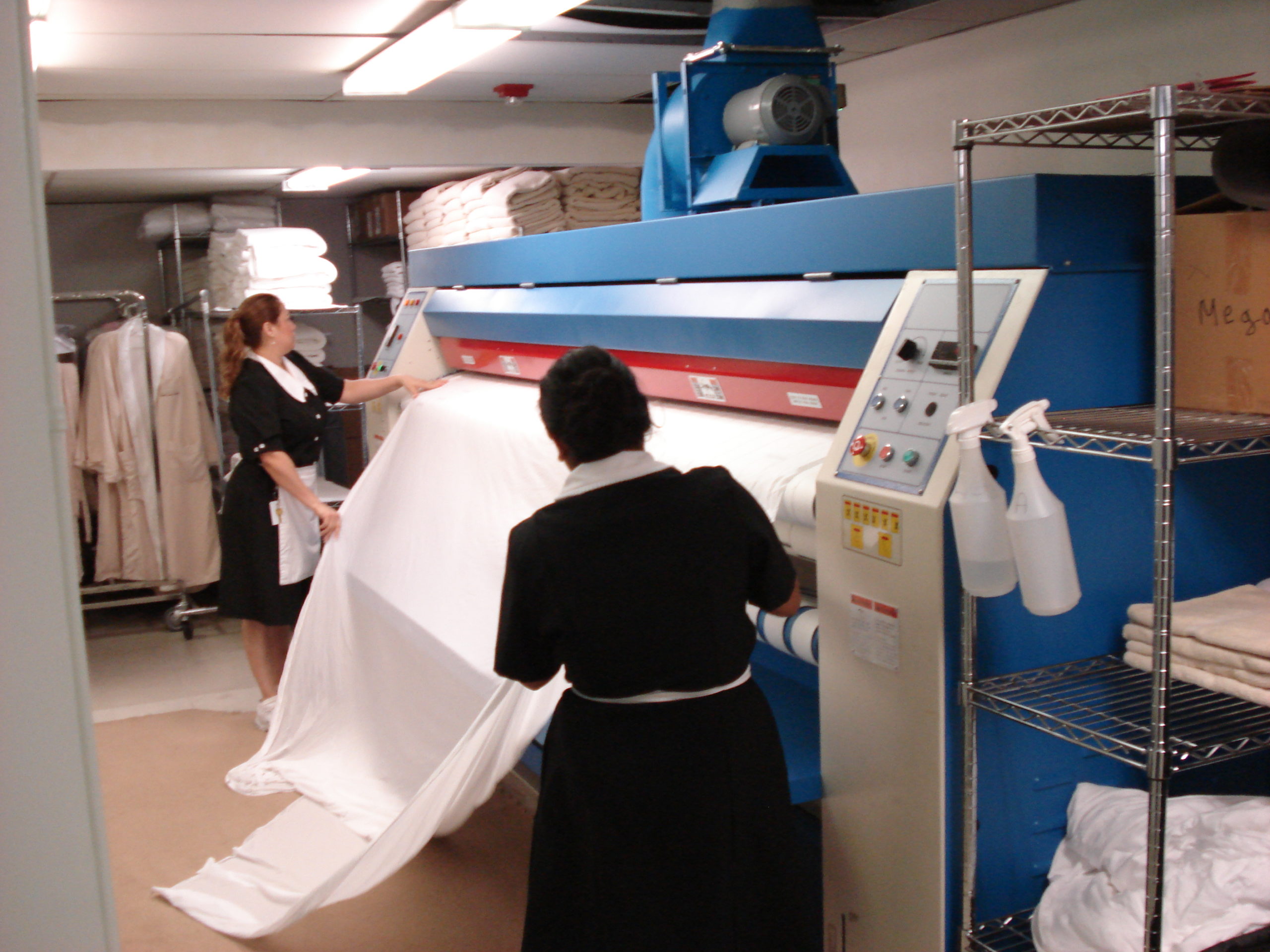
By Al Adcock, VP of Sales and Marketing at B&C Technologies –
When determining which ironer to choose for your industrial laundry or commercial laundry, there are several things to consider, from production requirements to service and everything in between. While this is not an all-encompassing guide, as site details vary widely, this guide aims to be a starting point of things to think about when researching ironers for your facility.
Production requirements
There are many different types and sizes of commercial ironers in the marketplace and the first things to consider is the size of the ironer and how it relates to your production requirements. One easy rule of thumb for sizing an ironer is the capacity of your washer-extractors. For example, if you have 2x 65-pound washers, you can reasonably expect to produce about 130 pounds per hour at a minimum. Therefore, your starting production rate for the ironer should be approximately 130 pounds per hour. You can of course slightly reduce this number since most facilities will be washing a combination of items, some of which won’t be ironed. However, if the soiled laundry is delivered in batches, it could be that you are processing a large amount of flat goods for several hours at a time, necessitating the full capacity of your laundry.
Also of primary concern is the working width of the ironer. If you are ironing king sheets or large tablecloths, it is wise to choose an ironer with a working width that can accommodate these sizes, assuming you have the space in your facility. Otherwise, you will be forced to fold the pieces in half prior to ironing, costing time prior to introducing the piece, as well as slowing the production rate of the machine.
Finally, the type of washer-extractor plays an important role in the productivity of the ironer. Softmount washer-extractors with extraction forces of 300-400G will provide the optimum moisture retention to allow the ironer to run at high speeds while providing quality results. Hard mount machines with extract speeds of 200G will require you to slow the ironer significantly or force you to condition the goods in the dryer for 8-10 minutes prior to ironing. Double handling the goods in this way reduces the efficiency and productivity of your facility. Finally, be wary of high-speed hard mounts that claim to extract at 400G. While the machines may occasionally reach these extract speeds, the problem lies with an extract speed that completely depends on the amount of imbalance in the wash cylinder prior to extract.
The problem with a varying extract is uncertainty in moisture retention, causing unpredictable results. If the goods extract at 400G, the ironer needs to run at a fast speed. Conversely, a 100G extract will require much slower speeds. All of this will add up to confusion amongst the operators of the ironer since there is no way to tell what the moisture retention is. If you’re interested in learning more about this subject, we’ve got an excellent blog post that goes into quite a bit more detail.
Floor space requirements
Ironers are relatively large machines that require space for service. When choosing an ironer, ensure that you have adequate floor space for operation and service. All manufacturers supply information and specifications about operational space as well as required service space. Ignoring these recommendations will be cause for heartburn later when service is required. Gas ironers will have a large gas burner that will need occasional service, so enough space should be left or there should be enough room so that the machine can be moved to accommodate this service. Finally, ensure that there is enough room for the operators to have space to work. Keep in mind that they will be pulling the flatwork from a laundry cart and there should be ample room for both operator and cart.
Utility Requirements
Most ironers use gas, steam, electricity, or thermal fluid as the heat source. Ensure that your utility supply is adequate for the ironer. These requirements can be found either in the installation manual for the machine or on the general specifications for the machine. Undersized utilities will cause operational headaches and prevent the machine from operating at its highest efficiency.
Ensure that the venting for the machine is designed and installed properly. As the venting removes moisture and combustion by-products, it is critical that the venting operate as efficiently as possible. Poor ductwork execution will cause operation problems and greatly reduce the efficiency of operation.
Lastly, ensure that there is proper make-up air for the ironer. Without proper make-up air, the ironer won’t be able to efficiently remove the moisture and combustion by-products from the laundry room. You’ll also see uneven results and likely a number of alarms and warnings from the machine.
Other Considerations
As mentioned above, softmount washer-extractors with an extract force of 300-400G are best suited to work efficiently with an ironer. However, the washer-extractor itself is only one component in this process. Wash chemistry is of critical importance as incorrect pH levels, the use of softener, and inadequate rinsing will all show up and create problems in the ironing process. It is important to work with a chemical company representative that is familiar with setting up wash processes for ironing.
Make sure to perform all scheduled maintenance on your ironer. This is the best way to protect your investment throughout its life. Allowing critical maintenance steps to go by the wayside is the surest way to heartache. An ironer has many moving parts that must all work in concert together to perform the task at hand. Planning for and performing maintenance is of the utmost importance if you expect to utilize your ironer to its fullest potential.
Lastly, waxing the ironer properly will allow the machine to press the goods with the finest results. Overwaxing will cause buildup and maintenance issues, while underwaxing will cause poor results. It’s important to determine the correct amount of waxing that is required for your particular laundry. A common rule of thumb is at the start of day and each shift change thereafter, but your particular requirements may differ wildly from this depending upon the type of machine, work rates, and material types.
There is nothing quite like pulling back the comforter on your hotel room’s bed and seeing crisply ironed and finished linens. Ironing means luxury.
About the Author:
 Al Adcock is VP of Sales and Marketing at B&C Technologies. He is an industry veteran with over 29 years of experience, working for different manufacturers in many different capacities before helping launch B&C Technologies in 2000. Adcock has played an instrumental role in the design of several machines on the market before moving to sales in 2013.
Al Adcock is VP of Sales and Marketing at B&C Technologies. He is an industry veteran with over 29 years of experience, working for different manufacturers in many different capacities before helping launch B&C Technologies in 2000. Adcock has played an instrumental role in the design of several machines on the market before moving to sales in 2013.
Based in Panama City Beach, FL, B&C Technologies is a family-owned customer-focused company that builds the highest quality laundry equipment at the most competitive prices. All B&C equipment relies on engineering-driven designs to produce machines that consistently perform and constantly produce.













